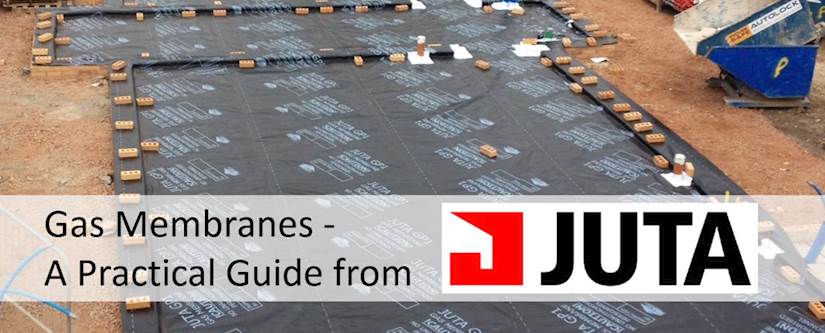
Gas Membranes - a Practical Guide
We regularly need to consider gas membranes during our projects and recently had a representative from JUTA over to talk about different types of membranes, their installation and best practice. They have kindly contributed their thoughts on ground gas membranes from the point of view of the manufacturer for our Part 1 on Gas Membranes -blog. Do check back soon for Part 2 in which we will be looking at the practicalities of verification and Local Planning Authority (LPA) sign off.
Traditionally a ‘Gas Membrane’ was simply a Damp Proof Membrane (DPM), which had resistance to ‘gases’. The type of gas was generally undefined, but consideration was primarily given to RADON (RN) gas resistance. As the construction industry evolves, and we learn from the mistakes of the past (Abbeystead 1984, Loscoe 1986, Gorebridge 2014) more focus is placed on hazardous ground gases and their long term effects on human health and the built environment.
The most common problems are caused by insufficient characterisation of the ground gas regime, and associated risks, inappropriate design, poor installation of protective measures, and a lack of foresight to future maintenance. The guidance for protective measures in constantly evolving, and we have come a long way as an industry from the dark days of old with loose laid recycled polyethylene membranes (PE) installed by unskilled workers. The most recent guidance contained within BS8485:2015, promotes quantifiable performance limits for the gas barrier materials, and skilled installation and verification of the systems.
As manufacturers we are now producing a range of specialist barrier membranes, which have specific resistance to an array of hazardous ground gases, and are tailored to bespoke application scenarios. The technological advances over the last 10 years enable us to produce unique membranes which are not only more cost effective, but are significantly better performing than the standard ‘1200g/2000g PE membranes’ of old. However! As an industry we still have a long way to go; as the standards change, manufacturers are expected to produce instant solutions! As such we are in a constant state of development to provide new and improved protective systems.
Ground Gas – Defined as hazardous and trace gases from the ground – The main ground gases are Radon, Carbon Dioxide, Carbon Monoxide, Methane, Hydrogen Sulphide, Oxygen, Nitrogen and Volatile Organic Compounds (Hydrocarbon Vapours).
Hydrocarbons – In liquid and vapour phase. Liquid phase covers contaminants suspended in the groundwater, and vapours are those in the air. Dependent on the application, a ‘gas barrier’ must be able to resist both phases.
Material selection – Appropriate barrier selection must be made in consideration of a combination of site specific conditions. A gas barrier which is suitable for protecting residential housing plots, may not be suitable for a large private development.
Basements – A focus point for the industry as we run out of space around us we look to burrow below our living spaces to create habitable environments. The challenges we face when constructing below ground level are quite complex in relation to ground gases and ground water contaminants. Guidance related to the use of materials above ground is not necessarily suited to application conditions below ground.
Get involved – It’s important to include the advice and guidance of specialist environmental consultants and manufacturers of barrier materials at an early stage in the project. The earlier in the process we are engaged, the better suited we are to advise on the most appropriate, cost effective sustainable solution.
Evolve – In a relatively short space of time (2 years) we have seen huge leaps forward with regards to the sophistication of barrier materials. There is no doubt that the barrier materials of the future will be vastly different to the ones of today! As the need for development on brownfield sites increases, so do the demands of the protective measures required to combat the ‘nasties’ retained in the ground from previous site uses. Keeping abreast of changes to the working standards is critical in our industry, and we welcome the feedback of the industry to enable us to provide the most practical solutions moving forward.
If you require any information or assistance, or just want to chat about your project requirements, the industry in general, or the range of solutions JUTA can provide: Please contact Patrick Flood patrick@juta.co.uk Tel: 01772 754177.